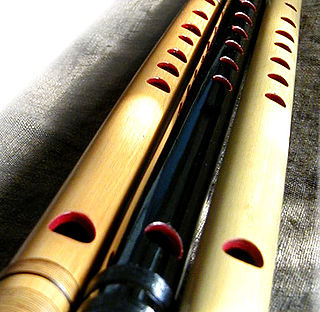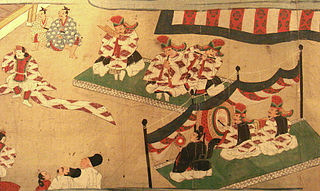Related Research Articles

Taiko are a broad range of Japanese percussion instruments. In Japanese, the term taiko refers to any kind of drum, but outside Japan, it is used specifically to refer to any of the various Japanese drums called wadaiko and to the form of ensemble taiko drumming more specifically called kumi-daiko. The process of constructing taiko varies between manufacturers, and the preparation of both the drum body and skin can take several years depending on the method.

Kabuki (歌舞伎) is a classical form of Japanese dance-drama. Kabuki theatre is known for its heavily-stylised performances, the often-glamorous costumes worn by performers, and for the elaborate kumadori make-up worn by some of its performers.

Japanese traditional dance describes a number of Japanese dance styles with a long history and prescribed method of performance. Some of the oldest forms of traditional Japanese dance may be among those transmitted through the kagura tradition, or folk dances relating to food producing activities such as planting rice and fishing, including rain dances. There are large number of these traditional dances, which are often subfixed -odori, -asobi, and -mai, and may be specific to a region or village. Mai and Odori are the two main groups of Japanese dances, and the term buyō (舞踊) was coined in modern times as a general term for dance, by combining mai (舞) and odori (踊).

In Japan, music includes a wide array of distinct genres, both traditional and modern. The word for "music" in Japanese is 音楽 (ongaku), combining the kanji 音 on (sound) with the kanji 楽 gaku. Japan is the world's largest market for music on physical media and the second-largest overall music market, with a retail value of US$2.7 billion in 2017.

The shamisen, also known as the sangen or samisen (all meaning "three strings"), is a three-stringed traditional Japanese musical instrument derived from the Chinese instrument sanxian. It is played with a plectrum called a bachi.
Shinto music is the ceremonial and festive music of Shinto (神道), the indigenous religion of Japan. Its origin myth is the erotic dance of Ame-no-Uzume-no-Mikoto which lured Amaterasu from her cave.

The hyōshigi is a simple Japanese musical instrument, consisting of two pieces of hardwood or bamboo often connected by a thin ornamental rope. The clappers are played together or on the floor to create a cracking sound. Sometimes they are struck slowly at first, then faster and faster.

Nagauta is a kind of traditional Japanese music played on the shamisen and used in kabuki theater, primarily to accompany dance and to provide reflective interludes.

The shinobue is a Japanese transverse flute or fue that has a high-pitched sound. It is found in hayashi and nagauta ensembles, and plays important roles in noh and kabuki theatre music. It is heard in Shinto music such as kagura-den and in traditional Japanese folk songs. There are two styles: uta (song) and hayashi (festival). The uta is properly tuned to the Western scale, and can be played in ensembles or as a solo instrument.

The kane or shō[kane] is a type of dish-shaped bell from Japan.
Kakegoe (掛け声) usually refers to shouts and calls used in performances of traditional Japanese music, Kabuki theatre, and in martial arts such as kendo.
The tonkori (トンコリ) is a plucked string instrument played by the Ainu people of Hokkaidō, northern Japan and Sakhalin. It generally has five strings, which are not stopped or fretted but simply played "open". The instrument is believed to have been developed in Sakhalin. By the 1970s the instrument was practically extinct, but is experiencing a revival along with the increased interest in Ainu heritage.

Traditional Japanese music is the folk or traditional music of Japan. Japan's Ministry of Education classifies hōgaku as a category separate from other traditional forms of music, such as gagaku or shōmyō, but most ethnomusicologists view hōgaku, in a broad sense, as the form from which the others were derived. Outside of ethnomusicology, however, hōgaku usually refers to Japanese music from around the 17th to the mid-19th century. Within this framework, there are three types of traditional music in Japan: theatrical, court music, and instrumental.
Tōsha Rosen VI is a Japanese percussionist in the tradition of traditional Japanese dance and drama, the sixth iemoto (head) of the Tōsha school. He specializes in the taiko and tsuzumi, and performs as a member or leader of the hayashi in the kabuki theatre, as well as in a variety of other traditional contexts.
The Nagauta Symphony is a symphony in one movement composed in 1934 by Japanese composer Kosaku Yamada.

A hayashi (囃子) is a group of performers who provide musical accompaniment for Japanese Nō or kabuki theatre, yose performances of rakugo, or a festival.
Etenraku is a Japanese gagaku melody and dance. It is usually played with a hichiriki or ryūteki, and is accompanied by other traditional instruments such as the shō, koto and kakko.
William Malm is an American musicologist known for his studies of Japanese traditional music. As a composer, teacher, and scholar of Japanese music, Malm shaped the study of ethnomusicology in the United States. Malm authored the first major scholarly study in English of the history and instruments of Japanese music, Japanese Music and Musical Instruments (1959). He was a faculty member at the University of Michigan from 1960 to 1994. Malm served as President of the Society for Ethnomusicology from 1977 to 1979 and was named an Honorary Member of that organization in 2004. Malm was awarded the Fumio Koizumi Prize in 1992 for his contributions to the study of Japanese music. As the 2001 Charles Seeger Lecturer, Malm's address focused on the history and founding of ethnomusicology in the United States.

Renjishi (連獅子), or Two Lions, is a kabuki dance with lyrics written by Kawatake Mokuami, choreography by Hanayagi Jusuke I and music by Kineya Shōjirō III and Kineya Katsusaburō II, first performed in 1872.

Shosagoto (所作事) or furigoto (振事), also known as dance or dance-drama, is a type of kabuki play based on dance. It is one of the three genres of kabuki, together with jidaimono and sewamono.
References
- ↑ Tai Whan Kim (1976). The Portuguese Element in Japanese: A Critical Survey with Glossary. Inst. de Estudos Românicos. p. 30. Retrieved 28 May 2013.
- ↑ Alison McQueen Tokita; Dr. David W. Hughes (2008). "The" Ashgate Research Companion to Japanese Music. Ashgate Publishing, Ltd. p. 204. ISBN 978-0-7546-5699-9 . Retrieved 28 May 2013.
- ↑ William P. Malm (2000). Traditional Japanese music and musical instruments: the new edition. Kodansha International. p. 244. ISBN 978-4-7700-2395-7 . Retrieved 28 May 2013.
- ↑ Santō, Kyōden (1783). "Sake Cup". World Digital Library (in Japanese). Retrieved 28 May 2013.
- ↑ William P. Malm (1963). Nagauta: the heart of kabuki music. C. E. Tuttle Co. p. 17. ISBN 9780837169002 . Retrieved 28 May 2013.